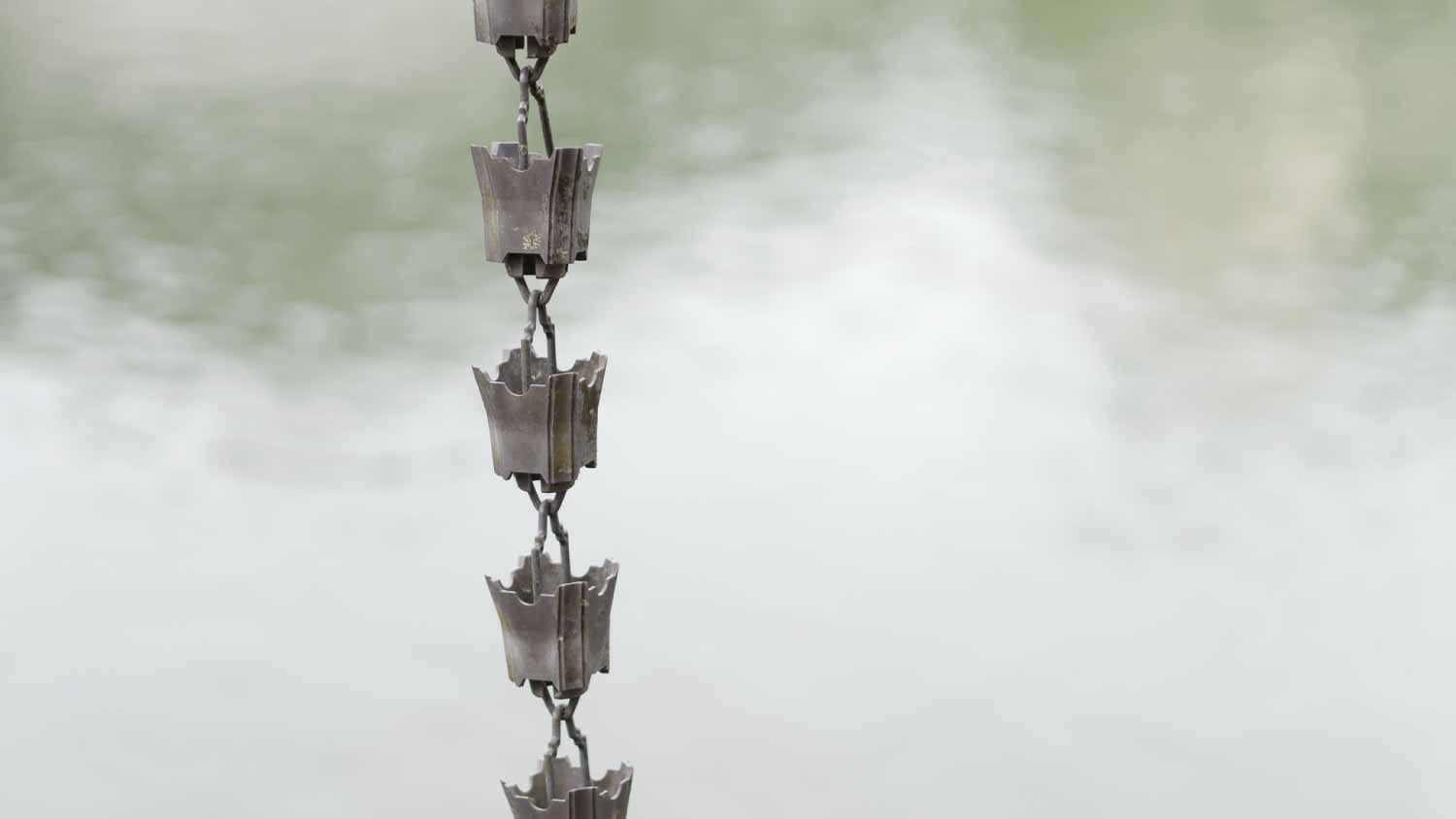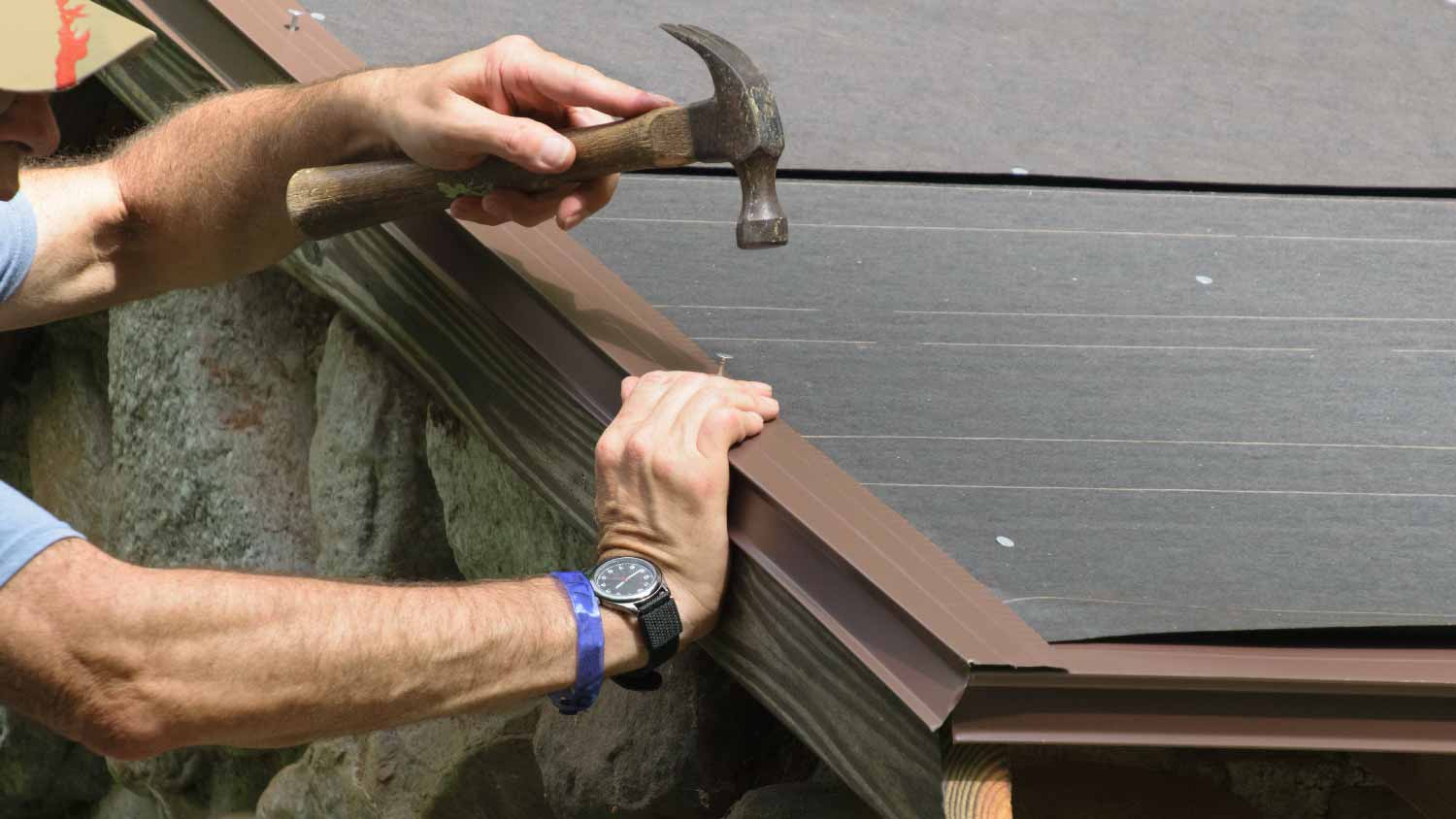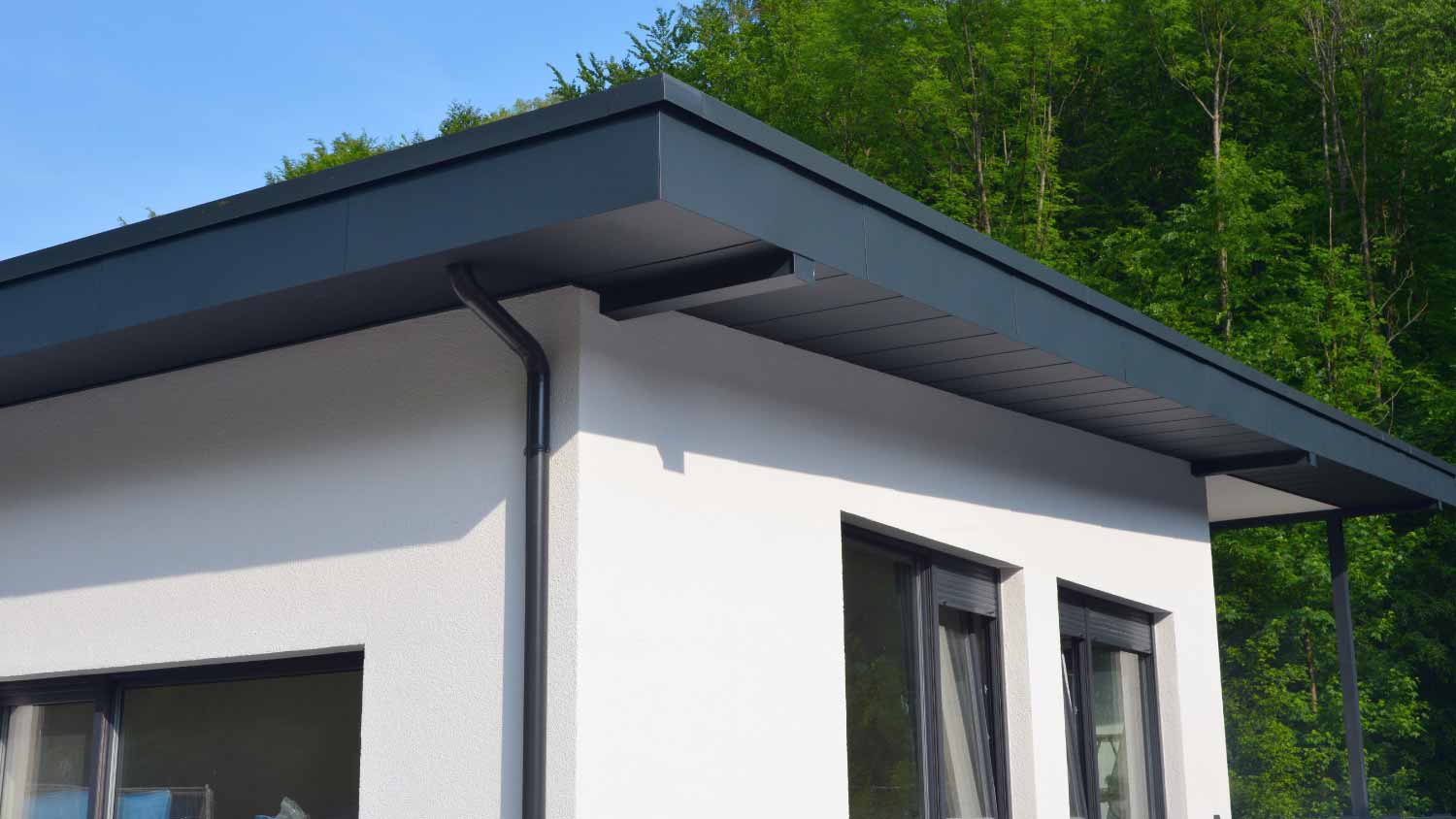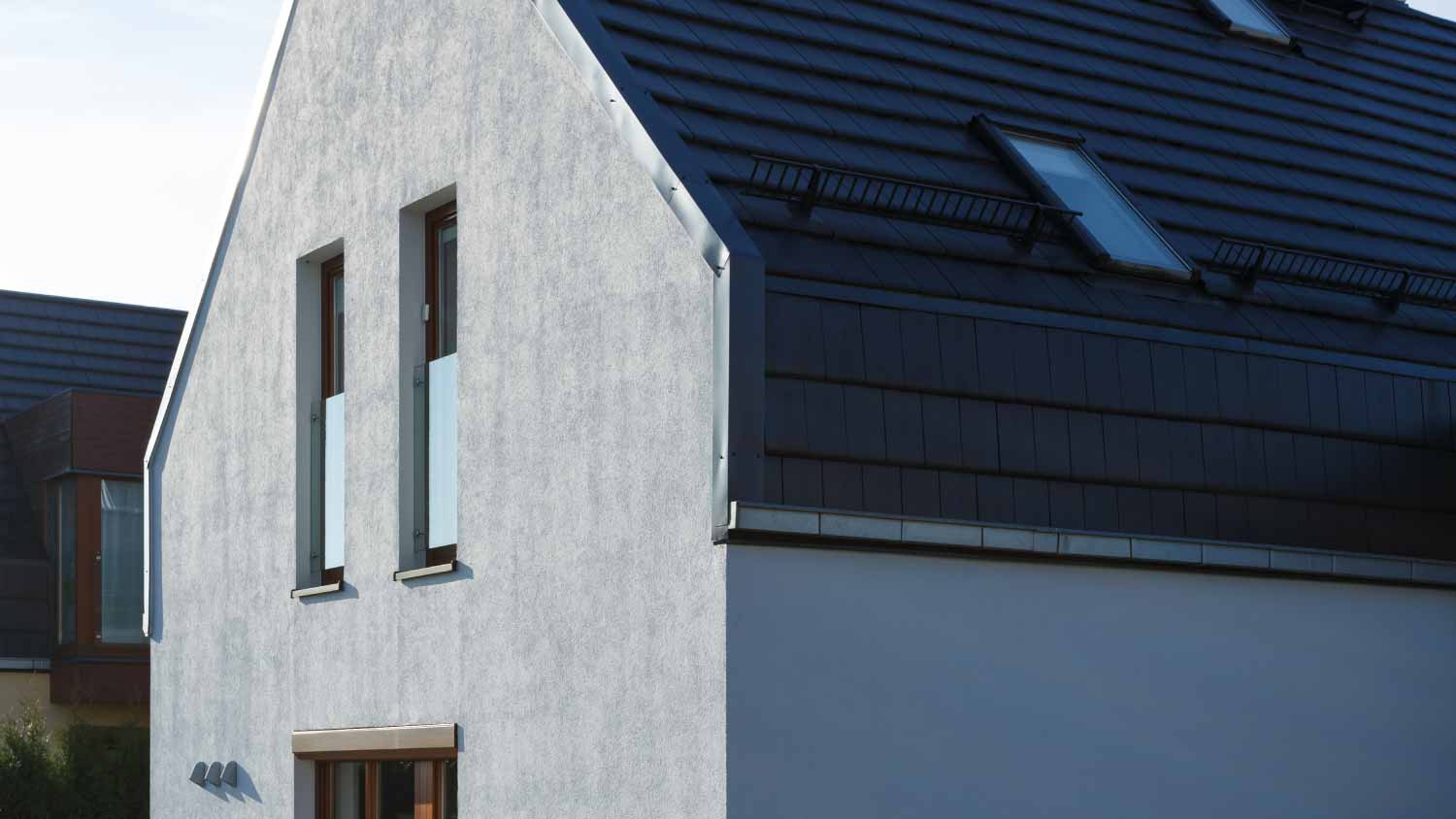10 Gutter Alternatives to Consider for Your Home
Traditional gutters aren’t the only way to channel water away from your house


Gutters and downspouts play an important role in directing water away from your home and helping to protect your roof, siding, and foundation from mold, rot, and other damage. But if standard gutter designs aren't meeting your practical or stylistic needs, there are alternatives. This rundown of popular water management features and systems will stir up some inspiration.
1. Aboveground Rain Chains

Rain chains offer an ethereal and aesthetically pleasing way to handle rainwater management. Commonly used as downspout replacements, rain chains transport rainwater from the roof or existing gutter system to a drain or cistern. These decorative and functional features can also work with drainage rocks, French drains, landscaped beds, or water features. Their goal is to direct water away from your home.
While installing a rain chain gutter can be an easy DIY project, you should consider hiring a pro to ensure that you don't damage your gutter system or roofline in the process.
The typical price for a rain chain is around $50 to $200, but prices can differ depending on the specific style and materials used. Copper rain chains tend to be on the higher end of this price range due to their durability and aesthetic appeal. However, some cheaper alternatives made from plastic or aluminum can be found for under $20.
| Pros | Cons |
|---|---|
| Flexible replacement for gutter spouts | Prone to splashing |
| Can be used as a replacement for gutters | May not handle heavy rainfall |
| Cost-friendly | Less sturdy and wind-resistant |
Best for: Homes—with or without a gutter system—that benefit from the stylish and practical redistribution of rainwater
2. Underground Rain Chains
As with your above-ground rain chains, underground rain chains work by vertically redirecting water from your gutters or roof edge down to the ground. The main difference is that underground rain chains have a two-part design. Once the water reaches the ground, a below-ground drainage system takes over to send the water packing.
Since rain chains typically replace downspouts, you won’t be able to use a downspout extension to redirect water from underground. But don’t worry—you have many options for the underground drainage system. Underground yard drainage systems that can go with a rain chain include French drains, dry wells, dry creek beds, catch basins, drip paths, and even land grading in some cases. The cost of your underground rain chain system depends on the type of rain chain, the number of rain chains, and the type of drainage system you install.
| Pros | Cons |
|---|---|
| Beautiful and functional downspout alternative | Cost varies by setup |
| Helps control water runoff | Requires two different parts |
| Versatile installation | Rain chains prone to splashing |
Best for: Homes that need additional drainage in addition to an existing rain chain system
3. Drip Edges

A drip edge is a fitted metal sheet that's installed at the roof's edge to prevent rot and mold. Its purpose is to direct water from your home's fascia into the gutter—or simply off the roof if you don’t have gutters. If a drip edge isn't installed, water can easily flow beneath your shingles to cause hidden roof and framing damage. While drip edges are required by modern building codes, some older homes may be without them.
Compared to gutter aprons, drip edges differ in that they don’t need an existing gutter system to be installed, whereas gutter aprons do need a gutter system. Drip edges are especially important for protecting your roof from damage caused by wind-driven rain. In high-wind conditions, wind can push water upward to penetrate a roof's protective underlayment.
A drip edge costs between $150 and $1,000 or around $575 on average.
| Pros | Cons |
|---|---|
| Protects your fascia from rot | Not every drip edge is made equal |
| Keeps water from seeping under your roof | Requires a pro |
| Prevents water damage from entering your home | Can be a little pricey |
Best for: All homes as added security against water damage to your roof, fascia, and siding
4. Drip Path
While it may look like a decorative accent, a drip path’s job is to channel water away from your foundation. Drip paths are made of materials like pavers, blocks, gravel, concrete, and stones; modern drip paths are sometimes made from metal or plastic materials. The drip path goes in the ground directly beneath your roofline and angles away from the foundation to help keep water from reaching your home.
How much your drip path costs depends on the type of material and length of the project. Overall, installing a drip path can be an affordable, DIY solution to direct rainwater.
| Pros | Cons |
|---|---|
| Decorative and customizable | Doesn’t protect your roof or surrounding areas |
| Helps prevent erosion | Can be a labor-intensive installation |
| DIY-friendly | May not be effective for heavy rainfall |
Best for: Homeowners in climates with low rainfall that want a decorative method for steering rainwater away from the home
5. French Drain

Considered one of the more intensive solutions to poor drainage, a French drain is essentially a "ground gutter." French drains work by collecting runoff so that it doesn’t pool up around your home's foundation. Unlike suspended drainage options, French drains direct water away from the home at the ground level. Water collected by a French drain can then be diverted anywhere approved by your local zoning laws; this usually means a storm drain, sewer, or cistern.
To create a French drain system, you'll need to excavate parts of your yard to build a trench. In this trench, you’ll bury perforated pipe within a layer of gravel. The pipe directs water toward your drainage area.
With French drain costs averaging $9,250, this is a professional project to consider if you’re concerned about water damaging your home's foundation.
| Pros | Cons |
|---|---|
| Very effective at protecting foundations | Requires excavation |
| Versatile installation | Can be expensive |
| Long lifespan | Not DIY-friendly |
Best for: Anyone looking to protect their foundation from flooding and long-term damage
6. Box Gutters

A box gutter is a channel that drains runoff away from your home using a pipe. This gutter alternative earned its name from its boxy shape. However, box gutters are also sometimes called parallel gutters because they run parallel to the structures they preserve. While this gutter alternative can redirect high quantities of water away from a structure, it does require professional installation and maintenance from a local gutter company.
Box gutters are different from ordinary gutters because they’re completely concealed from the outside of the building. While ordinary gutters are attached to the roof's perimeter, box gutters are fixed weight-bearing designs within the building's structure. Box gutters are primarily used on commercial buildings. They also generally work best with flat roofs. However, some people prefer them for architectural purposes on custom homes.
Aluminum box gutters can cost between $8 to $15 per linear foot, copper box gutters can cost around $15 to $25 per linear foot, and steel box gutters can cost around $10 to $20 per linear foot.
| Pros | Cons |
|---|---|
| Designed to handle heavy rainfall | High price tag |
| Adds style to homes | Complex installation |
| More resistant to clogs | Hard to clean and maintain |
Best for: Homes looking for a unique architectural design to go with their rainwater management system
7. Land Grading
If you have a sloping yard, you may need to start your rainwater management much farther away from your home than most people. Land grading is the process of changing the slope of your yard to redirect water from your home's foundation to a "safe" area. Effective grading requires a downward slope away from your foundation, reaching at least 6 inches for every 10 feet.
When you hire a company to grade your yard for drainage purposes, they will restructure your soil using bulldozers. They might also recommend pairing land grading with other drainage methods to help curb excessive groundwater if you live in a region with lots of rainfall. If you only need to address a few small areas of your yard, you may be able to fill in sloping spots with soil.
Homeowners can expect to pay anywhere from $1,000 to $3,300 for yard regrading costs, with the typical homeowner paying around $2,150.
| Pros | Cons |
|---|---|
| Can steer water toward desired areas | Comes with a high cost |
| Helps prevent erosion | Can destroy your existing landscape |
| Can protect against foundation damage | May not be effective enough |
Best for: Heavily sloped yards where rainwater runs toward the home
8. Rain Dispersal Systems
With a rain dispersal system, you don't have to worry about diverting large quantities of water that could pool around your foundation. Also called a rain handler, a rain dispersal system features special curved louvers designed to catch water as it rolls down your roof. The louvers then divide the flow of water to help create a sprinkling effect. By dividing the flow, a rain dispersal system reduces the impact that a rush of water has when hitting the area around your home's foundation.
A rain dispersal system like Rainhandler typically costs between $1.50 and $6 per linear foot.
| Pros | Cons |
|---|---|
| Helps prevent erosion | May be less attractive |
| Affordable alternative | Might not handle heavy rainfall |
| Providers gentle water to plants below | Can be challenging to install |
Best for: Homes in dry climates where a slow release of rainwater helps to water plants below
9. Hidden Gutters

Also known as built-in gutters, hidden gutters are installed into the structure of the roof's eaves. As the name suggests, hidden gutters have a design that blends in with the roofline. These gutters are made from materials such as copper, aluminum, or steel. (They differ from box gutters in that box gutters are situated within the building structure and are not visible unless you look up at the building's underside.)
In addition to being architecturally advantageous, hidden gutters have an enclosed design that can make them less susceptible to clogging caused by leaves, twigs, and animal nests. They also last longer than visible gutters. The average cost for hidden gutters installation ranges from $15 to $25 per linear foot.
| Pros | Cons |
|---|---|
| Hides unsightly gutters | Higher cost |
| Less likely to clog | Easy to neglect |
| Longer lifespan than traditional gutters | Harder to install |
Best for: Homeowners who want discreet gutters
10. River Rock Landscaping
River rock landscaping works similarly to land grading and French drains by creating slopes to direct water away from the foundation. To catch water as it falls off the roof toward the ground, you’d create a channel in the landing location lined with river rock a few inches deep. By sloping the channel, you can direct the rain away from the foundation. Some people describe it as creating a shallow “gutter” on the ground using river rock as the base. You often see this option used at the end of a downspout on a home with traditional gutters to direct water away.
Although it offers a natural look that some people find appealing, it is challenging to create the proper slope. The physical labor of digging a trench and moving the river rock into it is difficult, too. Using river rock as a base material prevents soil erosion as rain falls off the roof. The cost of installing river rock is $300 to $1,600 for materials and labor in a landscaping project. If you already use river rock in the landscaping around your home, though, you can save some money with this gutter alternative.
| Pros | Cons |
|---|---|
| Provides a natural look | Installation is pricey |
| Prevents soil erosion | Labor intensive project |
| Can match current landscaping | Slope needs to be perfect |
Best for: Homeowners looking for a natural-looking gutter alternative
How to Choose a Gutter Alternative
When trying to decide which gutter alternative to use, think about what will match your needs. Some gutter alternatives need a certain slope in the roof to provide the best results. If you have a large, sharply angled roof, most gutter alternatives would not work well because of the fast flow of large amounts of rainwater.
If you dislike the idea of splashing rain water, alternatives like rain chains would be a poor choice. Those who live in areas with high amounts of rainfall should stick with an option like box gutters or French drains, even though they’re pricey.
If aesthetics are important to you, look for a gutter alternative that matches your home’s design. You may want the gutter alternative to blend into the color of your home’s siding, roof, fascia boards, or landscaping to make it difficult to see.
Frequently Asked Questions
While gutters aren't legally required for homeowners, they are considered essential for protecting homes against rot, mold, roof leaks, and foundation issues. Your home may be an exception if it's fully surrounded by concrete, sits at the top of a hill, has a 10-inch overhang, or stands in a practically rainless climate. If you've purchased a home that doesn't have gutters, it may be time to either learn how to install gutters or call in a local gutter company before you experience water damage.
While gutters really only offer pros without any cons, some people dislike the appearance of gutters. Upgrading to an architectural option can help you to reduce the eyesore caused by mainstream gutters. In addition, some types of gutters are prone to expanding, contracting, or sagging if they aren't properly maintained. If enough weight builds up within a gutter system, your gutters can begin to pull away from your home.
Removing old gutters costs $1 to $2 per linear foot when you hire a professional gutter company to do the work. You may also have to pay between $150 and $350 to dispose of the debris. If you have aluminum or steel gutters, you can recoup some of the removal cost by selling the material to a recycler or a scrap metal collector.





- Why Is Water Leaking Between the Gutter and Fascia?
- Top 12 Gutter Drainage Solutions and Tips
- 6 Gutter Placement Tips for Hanger Spacing, Slope, and More
- 5 Reasons for Overflowing Gutters and How To Fix It
- 3 Best Types of Gutters for Metal Roofs
- A Clogged Gutter Can Lead to a Damaged Foundation—Here’s Why
- 10 Signs Your Gutters Were Installed Incorrectly
- What Are the Different Types of Gutters? [2024 Guide]
- 8 Common Metal Roof Gutter Problems
- Is Your Gutter in the Right Place? Here's What to Know








